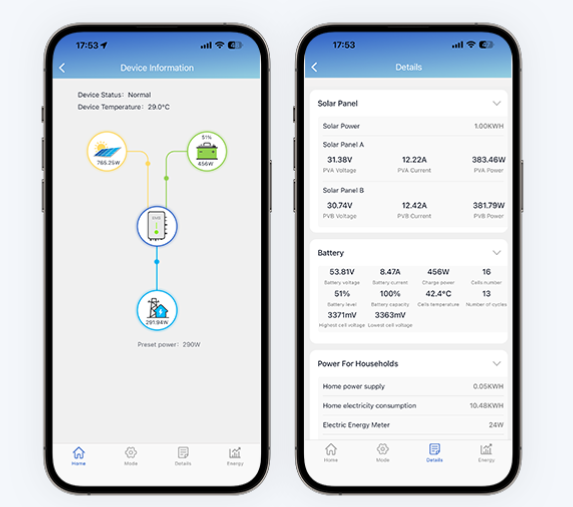As solar power becomes an increasingly popular energy choice for homeowners and businesses alike, many are looking for ways to maximize their return on investment (ROI). Solar Energy Management Systems (Solar EMS) are playing a key role in this effort. These systems provide real-time monitoring and control over the performance of solar installations, ensuring that energy production and consumption are optimized to deliver the best financial outcomes.
In addition to the operational benefits, there are also numerous financial incentives—such as tax credits, rebates, and net metering—that can significantly reduce the initial costs of solar power systems. When combined with Solar EMS, these incentives can be used to maximize savings and enhance the overall financial benefits of solar installations.

2. Understanding Solar EMS: The Basics
A Solar Energy Management System (Solar EMS) is a smart technology designed to optimize energy use, storage, and distribution in solar power systems. Smart energy management system typically includes components such as:
Monitoring: Real-time tracking of solar energy production, battery storage levels, and consumption.
Storage Management: Ensuring that energy produced by solar panels is efficiently stored and used when needed, reducing reliance on the grid.
Grid Connectivity: Facilitating interaction with the utility grid, including features like net metering, where excess energy can be fed back to the grid in exchange for credits.
Energy Efficiency: Optimizing the timing of energy use to take advantage of lower electricity rates and reduce peak demand costs.
By monitoring and optimizing these variables, smart energy management system ensures that solar systems operate at peak efficiency, thereby increasing the ROI for solar users.
3. Financial Incentives for Solar Installations
The initial cost of installing a solar power system can be a barrier for many homeowners and businesses. Fortunately, there are a variety of financial incentives available to help offset these costs:
Federal Tax Credit (ITC): The Federal Investment Tax Credit (ITC) allows solar users to deduct 26% of the total cost of installing a solar system from their federal taxes. This incentive significantly reduces upfront costs, making solar more affordable.
Rebates: Many states, municipalities, and utility companies offer rebates to encourage solar adoption. These rebates can reduce the upfront cost of installation even further, making solar systems more accessible.
Net Metering Programs: With net metering, homeowners and businesses can earn credits for excess solar energy they produce and feed back into the grid. These credits can be used to offset future electricity bills, essentially making solar energy a source of income when production exceeds consumption.
State-Level Incentives: Many states offer additional incentives, such as sales tax exemptions, property tax exemptions, or performance-based incentives, which can further enhance the financial benefits of going solar.
4. How Solar EMS Maximizes Solar Savings
A smart energy management system not only helps users track energy production and consumption but also maximizes the financial benefits of their solar system:
Optimizing Energy Use: An EMS solar system helps users monitor their energy consumption patterns and adjust them to minimize grid reliance. By directing power usage during the day when solar generation is high, or at night when electricity rates are low, Solar EMS ensures the system delivers the most savings.
Maximizing Battery Storage: Solar power systems often include battery storage, allowing excess energy to be stored for use when solar generation is low or during power outages. Solar EMS optimizes battery charging and discharging, ensuring that stored energy is used efficiently, thereby reducing the need to purchase electricity from the grid during peak times.
Increasing System Efficiency: A EMS solar system continuously monitors the performance of the system and alerts users to any potential inefficiencies or maintenance needs. By ensuring the system operates at peak performance, users can increase the longevity of their solar panels and batteries, which ultimately enhances their ROI.

5. Combining Solar EMS with Financial Incentives
When combined with financial incentives, home energy management system becomes an even more powerful tool for maximizing solar savings:
Tax Credit Maximization: The savings from incentives such as the ITC can be further maximized by the efficiency gains offered by Solar EMS. For example, reducing energy waste or optimizing battery storage can result in more energy savings, which lowers the effective cost of the solar system, thus enhancing the value of the tax credit.
Increased Rebates: Some rebate programs may be linked to system performance, so having a home energy management system in place could help demonstrate that the system is performing efficiently and in line with program requirements, ensuring that the user receives the full benefit.
Net Metering: By optimizing energy production and consumption, home energy management system can increase the amount of energy fed back to the grid, which can lead to higher net metering credits. This maximizes the financial benefits from both the solar system and the utility provider.
6. Application Process for Solar Incentives
Navigating the application process for solar incentives can be daunting, but with the right information and a few key steps, homeowners and businesses can easily access financial benefits:
Federal Tax Credit: To claim the ITC, users simply need to file the appropriate forms when submitting their taxes. Be sure to keep all receipts and documentation for the installation and equipment costs.
State and Local Rebates: Each state or local program may have different requirements, so it’s important to research the specific rebates available in your area. The application process often involves submitting proof of purchase and installation, along with any system performance data (which can be easily obtained through home energy management system).
Net Metering: To take advantage of net metering, users need to sign up with their utility provider. This process typically involves submitting system details, including capacity and installation date.
Solar EMS Data: Some incentive programs require proof of system performance or efficiency. Solar EMS can provide the necessary data to demonstrate that the system is meeting or exceeding program standards.
7. Latest Updates on Solar Incentives
The solar incentive landscape is constantly evolving. Some recent changes to be aware of include:
Extension of ITC: The ITC was extended at 26% through 2022 and is set to decrease to 22% in 2023. Homeowners and businesses should act before the credit drops.
State-Specific Changes: Some states have introduced new rebate programs or expanded their existing ones, while others have begun offering incentives for battery storage installations.
Policy Adjustments: Utility companies may adjust their net metering policies, potentially offering more favorable rates for excess energy fed back into the grid. Staying updated with these changes can help users take full advantage of available savings.
To keep up with the latest updates, visit your local utility company’s website, federal and state energy departments, and solar organizations for the most current information.
8. Conclusion
Solar power offers significant financial savings, and when combined with a Solar Energy Management System (Solar EMS), the return on investment can be even higher. Solar EMS optimizes energy use, maximizes battery storage, and ensures that solar systems operate at peak efficiency. By taking advantage of available financial incentives and combining them with the smart capabilities of EMS solar system, homeowners and businesses can reduce upfront costs, lower their energy bills, and enhance their ROI.
If you're looking to maximize your solar savings and future-proof your energy needs, now is the perfect time to explore how a Solar EMS can transform your solar system’s performance and financial outcomes.


